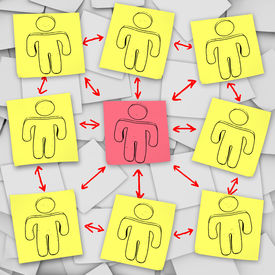How do you pick who works together, who reports to whom, and who exchanges information with whom? Usually it gets done within a department, within a project team, or based on some other common ground. It turns out we should be focusing on our differences a bit more.
We set out to create a fast but effective way to demonstrate this point: complimentary differences lead to good ideas. Co-workers who have complementary differences have unique skills or perspectives, and they have enough in common that they can communicate effectively with each other.

Our CEO Dave King and data scientist Alanna Riederer came up with a 20-minute exercise that uses nothing but sticky notes, a.k.a. The Sticky Note Exercise, and we tried it. We’ve since conducted this experiment on several more occasions, and each time participants have told us they are surprised at the useful things they learn in such a short amount of time. Whether it’s new information about the skills of a coworker or discovering similar problems faced by counterparts in other industries, people who play the sticky note game make meaningful connections.
So we’re sharing how to play. People have enjoyed it so much, it’s tempting to keep it to ourselves, but that would be antithetical to our company mission (to facilitate innovation)! So please help us be good stewards, and use this tool to help your group be more productive in ways that change the world for the better for the largest amount of people.
We’ve put instructions in a worksheet and turned it into a fillable PDF, so you can download the file and make the questions relevant to your specific group. Coming up with the right questions to ask can be the hardest part. You’ll be asking your people to think of a big project that they’ve worked on or are currently working on. Then they’ll be answering two multiple-choice questions about that project.
You want to have one multiple-choice question that helps categorize an important characteristic -- an attribute -- of the project. This question varies widely from group to group. Maybe the most relevant question for your group is “What role did you play in the project?” and the answer choices are “management, design, technician, or communications.” Maybe the most relevant question is “What was the focus of the project?” with answer choices like “biomedical, human-computer interaction, or data analysis.”
The other multiple-choice questions should categorize the main tool, technique, or skill used in the project. Depending on what’s relevant to your group, you may ask questions like “What resources did your project rely on the most?” with answer choices “Email, spreadsheets, code, or images.” Another example could be “Which data set was most important to your project?” with answers like “shapefiles, socioeconomic, biometric, or participant interviews.” These questions usually illuminate the most important artifact of a project, or the crucial thing created by humans.
In The Sticky Note Exercise, participants code their answers with different colored sticky notes. When everyone has completed their worksheet, they walk around the room looking for someone with just one color in common. In this way, the pairs that match up focus on projects with at least one thing in common and at least one difference. When all the pairs are matched (sometimes there are groups of three, and that’s okay), you -- the facilitator of the exercise -- start a timer for 10 minutes. The pairs discuss their projects briefly at a high level, and then get more granular when discussing the attributes or artifacts they have in common and what is different. (Groups of three may need an extra five minutes.) This is also when they discuss the answers to the open ended questions about the projects regarding what worked and what didn’t.
We’ve noticed there seems to be a critical mass of about 25 people that helps bring to light new ideas and information. Have more than 25 people? Even better. If you only have three people in your community, a coffee break is probably a better way to get to know each other and brainstorm. More people means more potential for new perspective. At larger scales, though, you need software to conduct this kind of exercise, collect the data, and suggest complementary differences among participants.
Our favorite part comes after people have matched and had a chance to visit. We ring a bell when people share a new insight generated through collaboration and complementary differences. People get excited about what they are learning and that excitement is contagious!
If you’re finding that you have trouble thinking of good questions for your group, we get it. It’s hard. Send an email to sticky@exaptive.com and we’ll help you get unstuck. Another side note: we usually have four answers for each multiple-choice question. We’ve seen some exercises that had success where Q1 had five answers and Q2 had three answers. Outside of that, you’re conducting your own experiment, so let us know if it works! We’d love to hear about your experiences with the exercise.
Related posts:
How Software Can Leverage Collective Intelligence and Facilitate Innovation
Cognitive What?! Explaining How to Assemble a Team for Collaboration

Comments